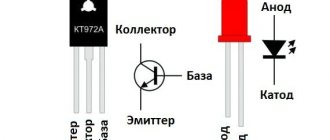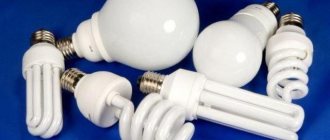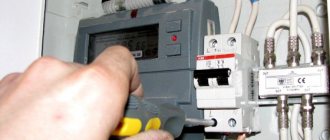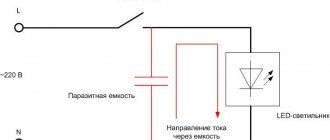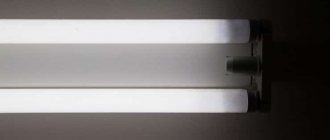If we compare incandescent lamps and energy-saving lamps, the latter are one step higher. This light source is much better and more progressive. Therefore, incandescent lamps are becoming less and less common, and housekeepers, although several times more expensive, are confidently pushing them out of our homes. Having purchased such a lamp, we have the right to expect impeccable performance from it. This is mostly true, but sometimes energy-saving lamps start to flicker. Why does the energy-saving lamp blink? Our article will answer this question.
Operation of an energy-saving light bulb
Both fluorescent and energy-saving lamps have the same operating principle:
- A glow discharge occurs between two electrodes placed in a flask into which inert gas and mercury vapor are pumped.
- The invisible ultraviolet radiation of mercury atoms, while passing through the walls of the flask, coated on the inside with a phosphor, turns into the light that we see. At the same time, the color of the light is different, it all depends on what composition was used to coat the inside of the lamp.
Interesting: Despite the fact that the voltage in our networks is alternating, the energy-saving lamp operates at constant voltage. The conversion of DC to AC voltage occurs in an electronic ballast using a diode bridge.
Reason #3: why the light blinks if everything is connected correctly
Sometimes the switch is not backlit, and the phase comes into contact with it, but the light bulb still blinks when the light is off. Then the reason is the poor condition of the wiring. It may be a matter of contact, or it may be a problem with insulation. If the contacts can be tightened, welded, or re-sealed, then problems with insulation can only be solved by completely replacing the wiring.
One thing: problems with insulation - this means a large leakage current. If you have an RCD (residual current device) on your line, it will often turn off the line. If there is no RCD and the wiring is old, you will not be able to determine this in any way. Or rather, it can be determined using an ohmmeter and the involvement of specialists. In case of significant damage, you can verify the presence of this problem using a multimeter and testing the wires to ground. Well, the light bulb blinks - this is a particular manifestation that the insulation is damaged and there are significant leakage currents.
Why do energy-saving lamps blink?
Imbued with the idea of saving energy, the man threw out all the familiar old lamps in the house and installed energy-saving ones. And how unpleasant it is when they suddenly start blinking.
Lights flash differently
Energy-saving lamps flash under different circumstances:
- when the switch is on, they blink constantly;
- at the moment of switching on and for some short time after;
- periodically;
- even when the switch is off.
Lamp is off but flashing
Why does the energy-saving lamp blink, because in theory there is no voltage in the network? But it turns out that the problem is not in the lamp, but in the switch with LED or neon backlight. And that's why:
- The power contacts close as soon as we turn off the switch.
- The illuminating lamp begins to burn.
- A very small electric current from the network transits through a lamp, chandelier with energy-saving light bulbs on the ceiling and returns to the network again. In this case, the capacitor in the electronic circuit of the energy-saving light bulb is recharged and the light bulb flashes.
- The capacitor instantly discharges and again everything repeats in a circle. That's the whole secret of the blinking of a switched off energy-saving lamp.
Conclusion: you cannot combine a backlit switch and an energy-saving lamp. Even if flickering doesn't annoy you, think about how much faster your not-so-cheap lamp will wear out. Due to the large number of launches, it will quickly use up the resource built into it and after a maximum of 2 months it will have to be thrown away.
There may be other reasons, namely:
- errors made during installation of electrical wiring;
- a lamp produced by an unscrupulous manufacturer.
The light flashes when the switch is on
As soon as the light turns on, the light bulb begins to blink. The phenomenon is very unpleasant, but what is its reason:
- The voltage level in the network is so low that the ballast of the energy-saving lamp cannot start it into operation. If so, then take a multimeter, bring it to the outlet and measure the voltage. If there is a deviation from normal (220 V) of 5%, we contact the electricity supply company with a complaint that the quality of the supplied electricity does not meet the established standard. After all, not only light bulbs can fail, but also household appliances.
- The commissioning device for the energy-saving lamp is faulty. There is nothing else left to do but buy a new lamp, because... The old one cannot be repaired.
- There are power surges in the network. All claims are against the power supply company, unless, of course, you perform welding work by connecting a welding inverter to the home network. Then that’s the reason, and you can’t do that.
Energy saving lamp flashes after switching on
This phenomenon occurs when you have an energy-saving fluorescent lamp that has an electromagnetic start system. When energy-saving fluorescent lamps malfunction, such as a faulty starter, a slow start occurs. Delay up to 10 sec. still acceptable, but if more, then change the starter.
Why the lights in the apartment are blinking: ways to solve the problem yourself
You are having dinner, or sitting comfortably on the sofa with a magazine. The light blinked, then again and again. Even if this happens occasionally, you must agree: when the lights in the apartment blink, it’s annoying. But in this case, is it always necessary to call an electrician, wait and incur additional costs? In some cases, the cause can be found and quickly eliminated yourself. Moreover, without any risk and without an electrical safety clearance group.
Warning!
But let us remember firmly: without the qualifications and skills of an electrician, without special tools and protective equipment, it is impossible to carry out work on ANY electrical equipment, including household electrical appliances! You can only use the standard controls without disassembling anything.
Electric shock will not warn you in advance, and its consequences are unpredictable and can be long-lasting. Especially if you have been drinking alcohol. Already from a shot of vodka, a person’s electrical resistance drops 1000 times, and an otherwise harmless pinch can turn out to be a fatal blow.
Option 1: The light bulb in the stationary lamp is blinking
First of all, why are the lights blinking in the apartment? If one light bulb in a stationary lamp (or one section in a chandelier) blinks, then either it, or the switch, or the wiring section between them is faulty.
Let's listen to the switch, with a closer ear. Do you hear something like a faint crackling or hissing sound? If yes, bad contact. The switch, however, may be in good working order, but dirt has just gotten onto the contacts or into the spring. Unscrew the flashing light bulb and quickly click the switch several times. Please note - with the light bulb unscrewed, no load! Otherwise, the already weakened contacts may burn out, and the switch will completely deteriorate. Screw in the light bulb again. Did it help? If not, move on.
We replace the flashing light with a known good one. If there is no spare, temporarily unscrew it from somewhere. Is that how it blinks? Well, the problem is in the wiring or in the electrical fittings of the lamp. This is already the work of the master.
Option 2: The light bulb, powered by the socket, is blinking
If the lamp plugged into the socket is blinking, try plugging it into an socket that is known to be working, go to several sockets in turn. Has it stopped blinking? The “original” socket is faulty and needs a technician and repair.
Is that how it blinks? We repeat the procedure for checking the switch and light bulb. Did not help? Well, the lamp needs to be repaired or replaced.
Option 3 (global): The light flashes throughout the entire apartment
- Let's say there is at least one room in the apartment where the light does not blink . Then, most likely, the problem is in the “dose” - the distribution box inside the apartment. There is no need to go there yourself, but your information may be useful to an electrician.
- Flashes “the whole apartment? “We look out the windows. If it also blinks in neighboring houses, there is a fault at the substation or in the main supply cable - feeder. You need to inform the emergency utility service or directly to the power grid dispatcher - the number will be given at the help desk.
- Do the lights in neighboring houses burn smoothly? Let's look into the entrance - how is it there, is it blinking? Let's ask the neighbors. Is it flashing at everyone’s entrance? The feeder from the substation to the house is faulty, or the equipment of the input switchboard in the house or the electrical distribution network in it. Here you definitely need to inform the municipal emergency department - house electrical networks are under their jurisdiction.
- Finally, is it only yours that is blinking? Perhaps the fuse (plug) of your apartment in the electrical panel on the staircase is faulty. If it is available and there is a spare, you can replace it. But! If the shield is sealed, DO NOT OPEN it under any circumstances! There will be problems and sanctions with the energy sector later. And for the same reason – plus fire and electrical safety – DO NOT INSTALL A “BUG” CORK with a homemade wire fuse. A fire caused by a bug is a very common situation.
Eliminating the causes of blinking energy-saving lamps
If, when buying lamps, you put quality at the forefront, and not the lowest price, then the issue of malfunction of energy-saving lamps disappears. All that remains is to look for the cause elsewhere and eliminate it:
- The first and easiest way to get rid of the lamp flickering when it is off is to open the backlit switch and open the circuit through which current flows to the lamp. The capacitor will stop being energized and the lamp will stop flashing.
- The second radical method is to change the switch with a light bulb to a regular one.
- The third is a compromise, i.e. and the blinking is eliminated and the backlit switch remains. A small current recharging the capacitor is neutralized by screwing 1 incandescent light bulb into a chandelier of 2 or several light bulbs. Of course, this will somewhat reduce energy savings, but it will allow the current to be diverted from the capacitor to the filament. There is one more positive point in this method:
- an energy-saving lamp turns on gradually, and an incandescent lamp turns on immediately, which means the chandelier will light up faster;
- The color of the radiation from an energy-saving lamp is not always comfortable, but in combination with the light of a conventional lamp this disadvantage is compensated. By the way, your eyes will be less tired.
4. The fourth method technically duplicates 3, only the addition will not be an incandescent lamp, but a capacitor or a 2 W resistor with a resistance of 50 kOhm as a shunt element. A small current will flow through it, but sufficient for the backlight to work.
Fighting blinking
There are several ways to eliminate blinking, let's look at them in order. The first reason is a backlit switch, so that the energy-saving lamp stops blinking, you can:
- Making an artificial break in the LED circuit is the easiest way; the switch can be disassembled painlessly. To do this, remove the key and the false panel, carefully inspect the wires and determine which one powers the LED or neon lighting. Bite off the contact on at least one side.
Turn off the LED
- If there is space in the lampshade or lamp, connect an incandescent light bulb to the circuit, which will become a shunt for the discharge current. After this, the spectrum of light temperatures will improve and the lamps will stop flashing.
- If there is neither room for a lamp nor the ability to disassemble the switch, you can connect a resistor to an energy-saving lamp. The installation location is more important - on the cartridge or in the junction box. A part with a resistor power of 2W is suitable. It is easy to solder and insulate, and will also act as a shunt.
- The most radical, but also effective way is to completely replace the backlit switch with a classic keyboard model. This method can be implemented when the replacement will not spoil the interior or you are still going to make repairs in the near future.
In other cases, act according to the circumstances - if the switch is installed in the gap of the neutral wire, it is worth changing the wiring connection in the junction box. If the contacts are weak, bend them or replace the failed units.
If the cables and wires in the power supply system have poor insulation, the problem can be solved by replacing the wiring. And the cause of low-quality energy-saving lamps can be solved by replacing the lighting device with a model from a trusted manufacturer.
High quality energy saving lamps
When buying energy-saving lamps, make it a rule to pay attention to who the manufacturer is. There is no doubt about the quality of the lamps, from such a well-known manufacturer as Philips. These lamps have good characteristics:
- heat generation is insignificant;
- lasts a long time;
- saves energy by 80%;
- turns on without blinking;
- provides luminous flux of 85%.
Another leader in the production of lighting equipment is the German company Osram. This brand is very popular, and lamps from the OSRAM DULUX SUPERSTAR and OSRAM DULUXSTAR series are distinguished by:
- warm, pleasant light, like incandescent light;
- almost instantaneous achievement of the planned luminous flux;
- excellent light output;
- long service life - 15 thousand hours;
- compact attractive design.
How lamps work and how it affects lighting
Problems with incorrect or rather untimely flickering of an energy-saving light bulb are rarely associated with network parameters or the quality of the wiring. Here the reason always lies in how the device works, or more precisely, in the principle of its power supply. For a better understanding, you should consider the design of the lamp.
It may seem that LED and fluorescent lamps are similar to traditional incandescent lamps, but the difference is enormous. The fact is that these two types of lamps operate under direct current or very high frequency current after rectification of the mains voltage and conversion. Why does this happen, you may ask, if alternating current with a voltage of 220 V is supplied through the household network? It’s very simple - inside each light bulb there is a miniature rectifier.
Moreover, at the input of each such device there is a simple microcircuit with a starting capacitor, a diode bridge and other elements. In a wide professional circle, this board is called ballast. To put it simply, the alternating voltage becomes rectified constant after it passes through the diode bridge. A smoothing capacitor is responsible for smoothing out ripples in the circuit. It is noteworthy that it is precisely this that is the reason why the light bulbs blink when they are off.
This problem is less common with lamps produced by well-known reputable companies. This is probably due to the higher quality of the build and raw materials. You can learn about the characteristics of lamps and their choice from the article about the best manufacturers of energy-saving light bulbs (for cross-reference).
Energy-saving light bulbs, by the way, blink not only when the switch is off. There are situations when they “sin” with this even when the light is on or immediately after it is turned on, either temporarily or permanently. However, this problem is most often seen when the power is off.
Malfunctions of energy-saving lamps
Let's look at what malfunctions of energy-saving lamps happen and how to eliminate them using the example of PHILIPS 6yr 23W ECONOMY.
Disassembling energy-saving lamps
We disassemble the housing of the energy-saving lamp in the following sequence:
- take a flat-head screwdriver and, moving carefully around the perimeter, push back the latches;
- disconnect the lamp cylinder by unscrewing the 4 wires with which it is connected to the electronic unit;
- We unsolder the wires connecting the base and the board. The block will remain in your hands. It is now possible to determine the fault.
Common faults:
- If there is increased voltage in the network, the capacitor will swell and leak, and the lamp will stop lighting. Here it is necessary to replace the CD and test all semiconductors.
- For the same reason, a malfunction such as breakdown of capacitor C5 occurs. The lamp glows only where the filaments are located. We change the capacitor.
- The reason for the incomplete glow of the lamp may be a rather long operation. In this case, the sealing of the flask is partially broken, and thermionic emission is reduced. We throw away the lamp.
- When one of the filaments burns out, the lamp stops burning. In this case, we check the serviceability of capacitor C5. Where the filament is broken, we unsolder the diode, and in its place we insert a 10 Ohm resistor.
- Another reason for the failure of an energy-saving lamp is a faulty diode thyristor (dinistor). This reason is detected by eliminating the malfunction of semiconductors, capacitors, inductor windings, and filaments. The solution is to replace the faulty element.
- If, by calling resistors and semiconductors, you see that they are out of order, then the parts, of course, must be replaced. But think about whether it’s worth doing this, because such repairs will be expensive. It's easier to buy a new lamp.
Watch how the author of this video eliminates the flickering of an energy-saving lamp:
Manufacturing defect
Another reason for the flickering of a light bulb may be poor quality manufacturing. Currently, there are a lot of defects on the market; products are not made according to standards and therefore fail almost immediately. After purchasing a light bulb in a store, you must immediately check it and, if any faults are found, ask to replace it with a working one.
Attention! If flickering occurs in an energy-saving light bulb, it is necessary to eliminate it as quickly as possible, since the element of the lamp that provides the glow, when flickering, is subject to a temperature difference due to the difference in voltage applied to it, which causes destruction (wear) of this element.
Return to content
Possible reasons
To consider the existing arsenal of reasons why an energy-saving lamp may blink, it is necessary to determine the circumstances under which an alternating glow occurs:
- flashes when the switch is off;
- flashes after the switch key is turned on;
- you cannot determine the flickering pattern.
Next, we will consider the principle of operation of energy-saving light bulbs, and how it differs from classic ones, the glow in which is provided only by incandescent filaments. Thus, in fluorescent light bulbs, mercury vapor is ionized due to heating of the filament inside the bulb. With the difference that the device glows on direct current, and not on alternating current.
Fluorescent lamps are connected directly to the AC network, therefore the converting element is contained neither in the chandelier nor in the switch, but in the lamp itself. An example of such a converter is shown in the figure below:
Rice. 1. Power supply for energy-saving lamp
This includes a rectifier bridge, a compensating and smoothing device, a starter, all of which are responsible for the usual glow of both energy-saving and LED lamps. Therefore, this problem is also inherent in LED lamps. In most cases, it is the presence of a capacitor in the lighting circuit that causes it to blink. Let's look at the reasons for the blinking of energy-saving lamps in more detail.
Backlight on the switch
This reason occurs when the switch in which the signaling LED is present is in the off state. The presence of LED backlighting is quite a convenient option, as it allows you to find the switch in pitch darkness. But, as practice has shown, because of this switching circuit, the energy-saving lamp blinks.
The reason is this:
Rice. 2. Illuminated switch connection diagram
As you can see in the figure above, the switch key operates in two possible positions - in the first it is a circuit of an energy-saving lamp, in the second it is a circuit of an LED indicating the location of the switch. Accordingly, when the switch is turned off, current will flow through the phase output to the contacts, the LED and through the neutral output back to the network.
Despite the fact that the energy-saving lamp is not used in the circuit, the flow of alternating current causes the presence of potential and the subsequent charge of the capacitor. When a sufficient charge is reached, the capacitor will discharge to light the lamp, but since the voltage is not sufficient to maintain constant burning, the lamp goes out.
Depending on the rate at which the flashing charge accumulates, the frequency of constant flickering will also depend. The reason in this case is the additional current path that is involved in the off position of the switch.
Electrical installation errors
If the switch you are using does not contain any backlight, and the light is still blinking, errors may have been made during electrical installation or during operation.
Among these reasons are:
- A zero is placed in the open circuit, and the phase connection to the socket contacts is made blindly, which is why potential is constantly present on the lamp elements. In this case, the reason why the light bulbs blink is identical to that described above - the capacitor is charged, which is discharged through the energy-saving lamp.
- Poor contact at the point where the wiring is connected to any of the circuit elements - because of this, the lamps also blink both in the on and off state. But finding a fault will require checking every detail.
- Leakage currents due to poor insulation also lead to the appearance of alternating potential on the capacitor plates, which is why energy-saving lighting devices may flicker.
Poor quality lamp
If you recently changed all the electrical wiring, replaced the chandelier and installed regular switches, the reason may be a low-quality energy-saving lamp. There are a number of manufacturers who save on components for lighting equipment, which is why various incidents can arise during operation, for example, when the lamp flashes.
The same reason may appear over time, when the warranty period has not yet expired, and the light bulb has already begun to act up. It should be noted that this reason is quite rare, but still occurs.
Poor quality lamp
Often the lamp breaks down and begins to blink simply due to the use of low-quality materials for insulating wires, cheap consumables for soldering circuit components (flux, etc.), violations of production technology (careless washing of circuit boards, etc.). All this leads to unpredictable results during operation, including the occurrence of leaks. Therefore, you should buy lamps from well-known manufacturers, although they are somewhat more expensive. A version of the rating of manufacturers of energy-saving lighting devices is shown in the table:
| Place | 1 | 2 | 3 | 4 | 5 |
| Manufacturer | Philips | LIGHTSTAR | UNIEL | OSRAM | Camelion |
| A country | Netherlands | Italy | China | Germany | Hong Kong |
You should also pay attention to the Russian brand Era.
It should be taken into account that when disassembling failed lamps, traces of condensation accumulation are often found. Most lamps have a leaky design, which over time leads to massive failure of lamps operated in conditions of high humidity. This can also cause current leaks inside the energy-saving control circuit.
Important! This method does not require additional costs; it only requires a spare lighting element. In order to save time and money on troubleshooting, it is recommended to do a trial replacement of the lamp first. Further diagnostics should be carried out in case of an unsuccessful outcome.
How to eliminate the cause of the indicator
1. Remove the indicator. To do this, you need to disconnect the indicator from the switch circuit according to the diagram. In the off state, the current that charges the capacitor in the energy-saving lamp does not flow into the lamp, since the circuit is broken.
2. Insert a low-power lamp with an incandescent filament, for example, 30 W, together with an energy-saving one. When installing this lamp, a small part of the current is spent on heating the filament and the capacitor, which acts as a voltage ripple filter, is not charged. If a chandelier is designed for only one light bulb, what to do in this case?
3. Install an additional resistor. It is necessary to install a 2 W 50 kOhm resistor parallel to the lamp in the electrical circuit, which acts as an incandescent lamp.
4. Buy a switch that does not have an indicator and install it.
How the housekeeper works
First, we need to tell you briefly about how this light source works, because... It is in the internal system that there may be problems.
Fluorescent and LED lamps, unlike other products, operate on direct current. This happens as follows: alternating 220 V is supplied to the base, after which the electricity passes through the diode bridge and the filter capacitor. As a result, the alternating voltage is converted into direct voltage, which is what we have at the output. It is the capacitor located on the board that can cause the light bulb to flicker.
As you can see, the design of LED and fluorescent light sources is really different, so if you screwed in a regular incandescent lamp and see that the blinking has gone away, you don’t need to think that the problem was a low-quality housekeeper (although there may be simply a defective product).

